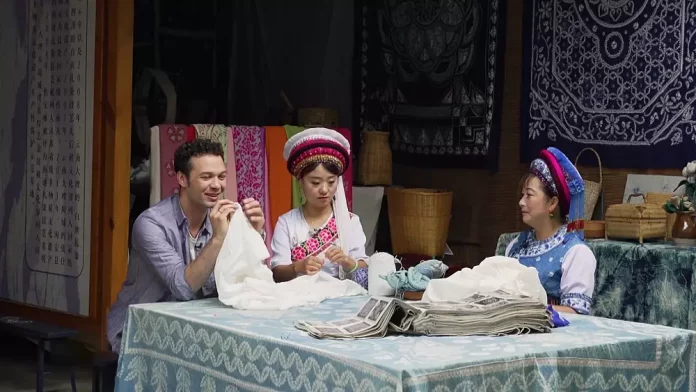In the western Scottish Isles, it is the local plants and lichens that inspire Harris Tweed makers. In southwest China, the Bai people use woad to dye their clothes. On the opposite side of the planet, artisans combine nature and tradition to create iconic garments.
nature and tradition
The Outer Hebrides of Scotland are on the edge of North West Europe. The incredible landscape is the inspiration for the colors woven into the famous cloth made here.
Harris Tweed Hebrides One of three weaving mills on the island. Production and Design Manager Callum Ian Macleod shows the reporter around.
“It’s 100% Pure New Wool”He says “That’s the only thing we’re allowed to use for Harris Tweed. We can’t use any fiber other than 100% wool.”
The factory produces more than 50 base colors. After this, wool of eight different colors is woven into yarn. This creates characteristic color gradations and mottled yarns. Harris Tweed is protected by Parliament and subject strict rules: The cloth must have been hand-woven by the people of the Outer Hebrides.
After weaving, the fabric is returned to the factory for cleaning and filling, and is then prepared for certification.
“It will be presented to the Harris Tweed Authority, which will mark it with the famous orb logo”Callum explains. “This stamp must be there to be recognized as Harris Tweed”.
Harris-Tweed was recognized as a registered trademark in 1910 and has since had “Orb and Maltese Cross” (Orb with Maltese Cross) as a distinguishing mark. The fabric is stamped from 1911. With the passage of the Harris Tweed Act of 1993, the previous definition of Harris Tweed became law.
To this day, Harris Tweed is the only fabric still produced on handlooms and still sold in large quantities. Tweed fabric is subject to strict control and since 1910 has been the only fabric protected by substantive law in Great Britain. Said to have been a favorite fabric of Queen Victoria, it is growing in popularity among fashion designers.
a global brand
Harris Tweed clothing has global appeal. “We have visitors from all over the world and everyone knows Harris Tweed”Store Manager David Galloway says walker slater menswear in Edinburgh. “They’re at the center of our business. They know they’re going to wear the merchandise for a lifetime. They know the story, they want the fabric, they want the weight, the color, they want everything, all Natural things that have been associated with Harris Tweed and the entire history of this brand.”
Chinese Origins of Batik Dyeing
Zhoucheng Village is located near Dali City in Southeast China. It is the hometown of Bai Batik dyeing.
Batik is one of the three traditional printing techniques that originated in ancient China. She combines many different skills to create beautiful patterns.
Vod is at the heart of the process. The Bai people extract the pigment from the plant for dyeing. They have a unique process which involves a total of eight steps. Binding and dyeing are the most important steps.
“In tie dyeing, dye making is the first creative step”Bai tie-dye master Duan Yinkai, who comes from the Bai family, explains. “Then comes the binding off, that’s the second step. You have to keep the stitches even.”
The motifs in the left ribbon represent nature. Each line tells a story about the environment around it.
Finally, a miracle is witnessed: the laces are cut and the threads removed from tangled places to reveal the pattern hidden between the tight knots.
Gotta be careful. One small slip and you could have a hole that will ruin the entire piece of fabric.
It’s the unpredictable results that make coloring so exciting. You never get two identical patterns and colors.

Freelance twitter maven. Infuriatingly humble coffee aficionado. Amateur gamer. Typical beer fan. Avid music scholar. Alcohol nerd.







